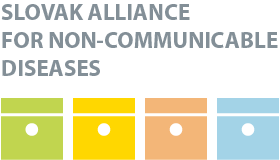—
HPI Network > HPI - Health Policy Institute > Health System in Slovakia > 6. Principal health reforms > 6.3 Key elements of the health reform, 2002–2006
6.3 Key elements of the health reform, 2002–2006
Friday, 06. May 2011, 20:10 — HPI
| << PREVIOUS
6.2 Reform period, 2002–2006 |
Introduction – Organization – Financing – Resources – Provision – Reforms – Assessment – Conclusions – Appendices |
NEXT >>
6.4 Future reforms |
- 6.3.1 Introduction and subsequent abolition of user fees
- 6.3.2 Transformation of health insurance funds into joint stock companies
- 6.3.3 Debt settlement through the state consolidating agency
- 6.3.4 Flexible prices and free payment mechanisms
- 6.3.5 Flexible network and selective contracting
- 6.3.6 A flexible basic benefit package
- 6.3.7 Establishment of the independent HCSA
6.3.1 Introduction and subsequent abolition of user fees
The implementation of user fees in June 2003 was aimed at reducing the demand for health care. They were set at €0.67 for a doctor’s visit in ambulatory care (both primary and secondary), €0.67 for a prescription, and €1.67 for each day of a hospital stay. The user fee for using the first aid services was set at €2. The constitutional legitimacy of the user fees was confirmed by the Constitutional Court in May 2004. The impulse for constitutional inspection of user fees came from opposition members of Parliament, who argued that user fees violate the constitutional right to free health care provision. The Constitutional Court ruled that user fees are in accordance with the Constitution. They are legislatively defined as administrative fees linked to health care delivery. Moreover, the financial burden resulting from these fees was not considered as an access barrier, since financial compensation was paid to low-income groups to cover these fees.
According to data from the General Health Insurance Company, the largest health insurance company in Slovakia (Zajac, Pažitný & Marcinčin, 2004), the number of physician visits in primary care dropped by 10% in the second half of 2003 compared to the same period in 2002. Similar results were observed in first aid department visits (reduction of 13%). On the other hand, the changes to physician visits in secondary care (-2%) and hospitalizations (-2%) were not significant. The reduction in physician visits led to a reduction in prescriptions because nearly 95% of GP visits in Slovakia include prescribing a medication. More than 20% of patients required less medication prescribed when visiting a GP. From 2002 to 2004, the volume of drug packages sold in pharmacies declined by almost 8%.
In a survey (FOCUS, 2004), 1.5% of respondents pointed out that the introduction of user fees had impacted their behaviour and that they had stopped visiting a doctor. Up to 58.4% of respondents, however, did not change their behaviour. A decrease in demand was observed in 18% of the population that had restricted their physician visits. User fees were a new item on the list of family expenses. Such a change in the structure of expenses was not welcomed. According to 27% of respondents, fees have caused a serious or very serious financial burden. Elderly people and single parents with more than one child mainly expressed negative opinions (FOCUS, 2004).
Over 32% of respondents viewed corruption in health care as the most serious problem and it ranked second in December 2002. In January 2004, the same attitude was expressed by only 10% of respondents and corruption ranked seventh. The number of people who had offered a gift to a specialist physician in October 2003 dropped by 22%, a decline of over one-fifth compared to June 2002. A decline of one-quarter was observed in hospitals and in dental care facilities. The value of these gifts decreased on average by 40% in hospitals, by 23% in specialized care and by 30% in dental care. The implementation of user fees produced a substitution effect: people did not feel obliged to offer small gifts to physicians once they had paid a legal fee (FOCUS, 2004).
Public support for user fees was low and it had become a topic of heated political debate. Following the parliamentary elections in 2006 and the victory of the left-leaning opposition, the new government did not eliminate the user fees in the law, but reduced the fees in outpatient and inpatient care to €0. Fees for first aid visits remained the same (€2) and the fee for a prescription was reduced to €0.17. Data from the General Health Insurance Company show that after the implementation of fees in June 2003, the number of patient–doctor consultations and medical examinations fell from 17.3 to 15.7 in 2004, after which it increased slightly to 16.0 in 2005. After abolition of part of the fees, the number of patient–doctor consultations and medical examinations returned to roughly the 2002 level (see Fig. 6.4).
Fig. 6.4: Number of patient–doctor consultations and medical examinations, 2002–2007
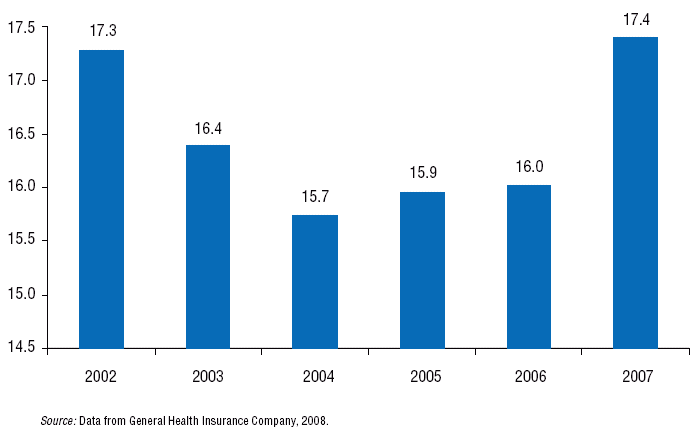
6.3.2 Transformation of health insurance funds into joint stock companies
The transformation of health insurance funds into health insurance companies, a change in nomenclature that indicates the transformation from a public institution into a joint stock company, was approved in 2004. Each transformation was left to the individual discretion of each health insurance fund. According to the law, if the fund was still against transforming into a health insurance company in 2005, it would be closed down. In the end, all five health insurance funds chose to become health insurance companies. Of the five new health insurance companies, two were state-owned and three were privately owned. In order to provide health insurance, the newly transformed health insurance companies had to apply for a licence at the HCSA, which was established in November 2004. Prerequisites for licensing were a basic property of €3.3 million, adequate organization and technical equipment. In addition, the individuals nominated to Boards of Directors and Supervisory Boards had to meet very strict criteria in terms of their education, moral and professional background. The original founders of health insurance funds became the first shareholders of the health insurance companies. The legal basis for health insurance companies is defined in the Commercial Code (lex generalis). The provisions that differ from the Commercial Code are outlined in the Act on Health Insurance Companies (lex specialis).
The transformation of health insurance funds into health insurance companies has stabilized the sector in terms of financing, as the companies were forced to become more prudent and effective at utilizing their own resources. After transformation, no new debt was created (Fig. 6.5).
Fig. 6.5: The effect of the transformation of health insurance funds into joint stock companies with hard budget constraints – debt as percentage of GDP
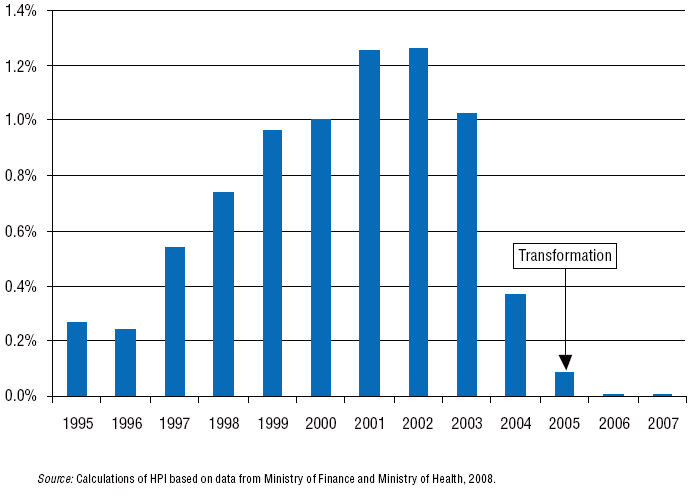
The transformation of health insurance companies in 2005 aimed to create an environment in which health insurance companies and health care providers would operate independently. To increase the incentives for good performance of both parties, the legislature allowed them to make a profit (see Table 6.4). Profit for health insurance companies is a reward for bearing the financial risk, purchasing health care and administering health insurance.
According to the Amendment to the Health Insurance Act adopted at the end of 2007, all health insurance companies must use their profit to purchase health care. This provision resulted in health insurance companies starting an international arbitration against Slovakia in 2008 for what they view as damage to their investments. In summer 2008 a group of opposition members of the Parliament filed a motion in the Constitutional Court regarding the constitutionality of this provision. In November 2009, the EC sent the Slovak government a letter of formal notice. In this notice the EC states, that “the prohibition on health insurance companies freely disposing of any profits resulting from the provision of public health insurance in Slovakia under section 15(6) of Act No 581/2004 constitutes an unjustified restriction on the freedom of capital movements guaranteed by Article 56 EC”. The government in power since July 2010 announced in its Government Manifesto a return to allowing health insurance companies to make a profit. In January 2011, the Constitutional court ruled that the profit restriction was unconstitutional and nullified it.
Table 6.4: Profit/loss of health insurance companies in € million
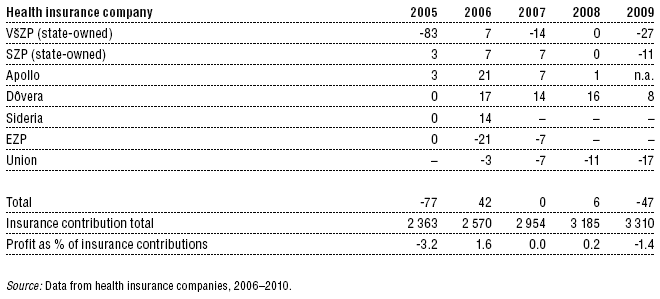
6.3.3 Debt settlement through the state consolidating agency
The main driving force of rising health care debt until 2002 was the debt itself. The highest contribution to the rising debt was from exchange rate losses, accrued interest on late payment (36.5% per year until 2002, after a change of the law it was reduced to 3.65% per year from 2003), court fees and sanctions. The profit margin of drug suppliers increased, reflecting higher costs associated with the growing accrued interest and currency risk. This resulted in an increase in costs related to health care provision. Corruption had become more widespread mainly because debtors were giving payment preference to those creditors from whom they had received bribes. The debt absorbed financial resources which otherwise could have been used to increase the quality and effectiveness of health care provision.
From 2000 to 2002, the government used €339 million from the non-recurring resources from privatization to clear health care debts. These resources were allocated using state grants either to health insurance funds or directly to hospitals. No audits to identify the structure of the debt were performed before providing these grants, which led to notoriously unreliable data on debt. Furthermore, the grants were not controlled effectively, the prioritization of creditors was not transparent and the grants were frequently used to cover everyday expenses or to purchase new technologies. The lesson from this type of debt settlement was bitter. As of 31 December 2000, the reported debt was approximately €664 million and two years later, after the debt settlement was “over”, it amounted to €996 million.
It became evident that effective debt liquidation depended not only on the accessibility of financial resources, but also on a proper debt-settlement technique. Therefore, a new state agency for the consolidation of health care debts was set up by the name Veritel. This agency repurchased from suppliers their receivables towards hospitals. In this process, receivables were thoroughly verified. The agency refused to pay for accrued interest and late fees. Instead, it focused solely on the principal, on which it demanded a cash discount of at least 3%. These steps saved considerable public resources.
As a result, the agency owned the receivables towards hospitals and the creditors were finally paid for products and services delivered in the past. The next step was that hospitals were allowed to pay their debts to the agency with their receivables towards health insurance funds. After this step, the hospitals were cleared of their debt and the agency owned receivables towards health insurance funds. The health insurance funds, in turn, were allowed to repay their debts to the agency with their receivables towards non-payers of health insurance, which amounted to €774 million in 2003. In the period 2003–2005, the agency settled debt in the health sector exceeding €1100 million in accounting value at the cost of €644 million in cash. Since the Ministry of Health announced that this was the last bail-out of the health care system, the agency was abolished in 2006.
6.3.4 Flexible prices and free payment mechanisms
One of the objectives of the health reform in 2004 was to increase the responsibility of health insurance companies in the purchasing of health care services. Since the reform was adopted, all pricing and payment mechanisms, with the exception of several market segments (such as drugs, emergency medical services and 24/7 first aid), are subject to contractual freedom.
Contracts with negotiable prices and deregulated payment mechanisms enable the absorption of potential financial or structural imbalances between health insurance companies and providers. Flexible prices enable health insurance companies to react to changes in system financing (with increasing resources they can increase prices for providers and vice versa) or to absorb structural imbalances in resource allocation in various areas of health care (for example, transfer resources between ambulatory and inpatient care).
The management of a free pricing system is more demanding for the regulator. If the regulator wants to influence health system financing, it cannot rely on simply changing centralized prices or payment mechanisms, but it has to use more complex indirect tools. Since 2007, state-owned hospitals are in a better position when negotiating contracts with health insurance companies. By government decree, state-owned hospitals fall under the minimum network requirement and must be contracted by health insurance companies. The practice of price agreements between state hospitals became the subject of investigation by the Anti-Monopoly Office of the Slovak Republic. According to a 2009 Anti-Monopoly Office report the hospitals behaved as a cartel. In spite of these problems, contracting has resulted in a greater differentiation in terms of prices and payment mechanisms among health insurance companies (see Table 6.5). The new government (since July 2010) declared the implementation of DRGs as the main payment mechanism for hospitals.
Table 6.5: Payment mechanisms used by health insurance companies, 2007–2008
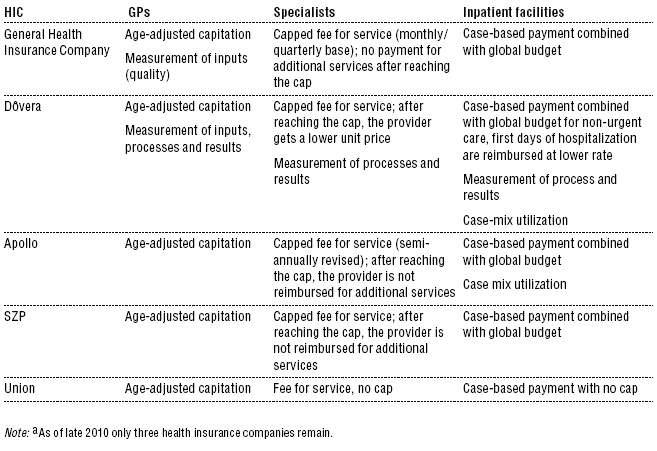
6.3.5 Flexible network and selective contracting
One of the key objectives of the health reform in 2004 was to increase the independence and financial responsibility of health care providers. The first step was to make the process of entry into the health care provision market more transparent and to remove any artificial barriers. The provider must acquire a licence from the specified medical chamber and then acquire a permit from the self-governing region or Ministry of Health. The liberalization of the health sector attracted new investors in pharmacies, hospitals, drug wholesalers, laboratories, diagnostics and polyclinics.
Market entry does not entitle providers to a contract with health insurance companies. The health insurance companies were allowed to selectively contract based on their own structural, procedural and outcome criteria. The health insurance company only had to fulfil the minimum network requirement, which seeks to secure access of citizens to health care through a minimum number of contracted providers in a given geographical area. The role of the HCSA was limited to controlling this minimum number. Which providers were in fact contracted was the contracting freedom of the health insurance company. However, in 2008 only the General Health Insurance Company and Dôvera were implementing the principles of selective contracting.
In 2007 and 2008, the Ministry of Health changed the definition of the minimum network in tertiary care from a minimum capacity into a fixed network of specific inpatient facilities. These facilities, which are all state-owned hospitals, are entitled to obtain a contract with the health insurance companies as they are deemed crucial in guaranteeing geographical accessibility. This is contrary to the original idea, where health insurance companies had the full freedom to choose which hospital to contract. The government in power since July 2010 announced in its Government Manifesto that the fixed network would be abolished and the minimum network requirement – and thus competition among providers – reinstated.
6.3.6 A flexible basic benefit package
Quiet rationing was a serious ethical problem and a source of corruption in Slovakia. The ambition of the reform acts in 2004 was to replace the practice of implicit, quiet rationing by explicit rationing. The idea was to set a transparent basic benefit package on the basis of medical, economic and ethical criteria. The rationale was based on a message of financial protection: scarce resources must be used to cover those diseases for which no individual could afford to pay. On the other hand, financial participation should be allowed for services that patients can cover individually without bearing catastrophic financial risk.
The drafting of the basic benefit package was based on an “equal treatment to equal need” principle. Under the given hard budget constraints, priority-setting in this process was inevitable. The identification of priorities was divided into two stages. In the first stage, a proposal was drafted on the basis of the Oregon priority list of diseases and treatments. In the second stage, the proposal was adapted to the Slovak cultural and societal context by a group of 28 physicians (GPs, specialists, academics). The group used the ICD-10 classification of diseases and identified the diagnoses which are considered as priority diseases (approximately 6700 diseases out of 11 000). In 2004, these represented 41% of all cases and 67% of all costs. The remaining 4300 diseases are on the non-priority list and represented 59% of all cases and 33% of all costs. For these diagnoses, co-payment may be required and set by a government decree.
The term “flexible basic benefit package” describes the legislative flexibility of this concept. The benefit package can be narrowed or widened by government decree and thus without complicated parliamentary negotiations prone to political opportunism.
Despite the fact that the law explicitly defined the priorities and the mechanisms for defining co-payments, they were never implemented due to political reasons. In 2008, no distinction was made between priority and non-priority diseases. All the non-priority diseases are free of charge. Therefore, the dominant components of private expenditure are co-payments for drugs and (private) direct payments to uncontracted providers.
6.3.7 Establishment of the independent HCSA
The HCSA was established in November 2004, right after the reform laws were passed in the Parliament. The HCSA was established to split the legislative and control function in the health care system. Until 2004, both functions were the responsibility of the Ministry of Health. Since 2004, the Ministry of Health has been responsible for setting the legislative framework for the health insurance market, the health care purchasing market and the health care provision market. The HCSA supervises whether health insurance companies and providers adhere to this legislative framework and intervenes when violations occur.
In the health insurance market, the HCSA licenses and monitors health insurance companies. The HCSA supervises the entry of health insurance companies into the market and their exit from it, imposes sanctions when necessary, orders recovery plans in case the health insurance companies do not meet solvency criteria and may even introduce forced management when the health insurance company is unable to manage its financial situation.
In the health care purchasing market, the HCSA monitors the minimum network requirement and the contracts between the health insurance company and the providers.
In the health care provision market, the HCSA controls the quality of care provided. The HCSA acts on behalf of citizens who feel their rights were violated or think that the care they or their family members received was not state of the art. Every complaint from citizens is filed and investigated. After the investigation, the citizen obtains a protocol with a statement of “state of the art” or “non-state of the art”. With this statement, the citizen can decide to litigate. The HCSA has a power to impose sanctions on providers.
Related articles
News
The amendment of the Decree on emergency medical service
Health insurance companies returned over 400 thousand €
The HCSA received 1,647 complaints last year
A half million people will earn more
Most of public limited companies ended in the black
Debt of hospitals on premiums has grown to nearly € 105 MM
Slovak health care may miss € 250 million next year
Profits of HIC amounted to € 69 mil. last year
Owners of Dôvera paid out money but did not paid taxes
Like us on Facebook!
Our analyses
- 10 Years of Health Care Reform
- New University Hospital in Bratislava
- Understanding informal patient payments in Kosovo’s healthcare system
- Analysis of waiting times 2013
- Health Policy Basic Frameworks 2014-2016
- Analysis of informal payments in the health sector in Slovakia
- Serbia: Brief health system review
developed by enscope, s.r.o.
